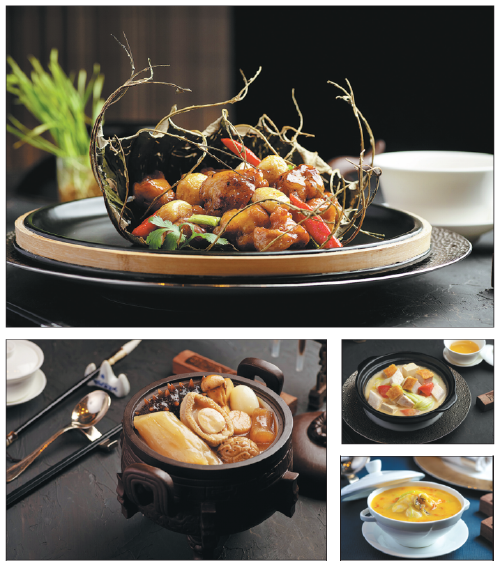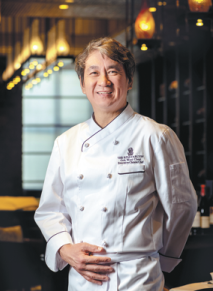Contemporary Cantonese
As a chef who has worked across Southeast Asia, Goh Wooi Cheat moved to the Chinese mainland to tap into his roots and offer local diners his own unique take on Guangdong cuisine, Li Yingxue reports.

Cantonese cuisine from Singapore used to be famous across Asia for its high-quality ingredients and exquisite plating, but after working in Beijing and Tianjin for several years, Singaporean chef Goh Wooi Cheat firmly believes that "the future of Cantonese cuisine lies in China".
"All the finest ingredients from around the world can be now found in China and the chefs' plating skills are improving fast," the 56-year-old chef says.
Goh's ancestors moved to Malaysia from Guangdong province, so he has been familiar with Cantonese cuisine since childhood.
Growing up in Penang, Goh remembers always hearing about portions, ingredients and seasoning at home because his family ran a catering business.
He moved to Singapore and became an apprentice Cantonese chef in 1983, becoming an executive chef 10 years later. He also worked in five-star hotels in Indonesia for a couple of years where Cantonese wedding banquets were an important element.
"There are no pork dishes in banquets in Indonesia, but overall the tradition for Chinese cuisine wedding banquets are similar across Southeast Asia," Goh says.
He was inspired by the pumpkins his family used to make soup in Indonesia and brought the inspiration back to Singapore, adding mashed pumpkin to soup bases to add more color and reduce the aromas from the meat.
In 2011, Goh received a job offer from Beijing, which he promptly accepted.
"I felt proud about returning to China, the land where my ancestors hail from-especially since I believe that real Chinese cuisine should be served to Chinese people," Goh says.
Goh used to lead his team to serve large dinners to thousands of people. Three years ago, he prepared a buffet for 5,000 people with a team of 20 chefs.
"The process is totally different when you are designing a menu for 5,000 rather than 10 people," Goh explains. "Food safety is the most important thing in mind as you can't cook everything at the same time. Some dishes have to be prepared the day before and put into insulated containers, and the meat and seafood must always be properly cooked."
Goh thinks that the quality of ingredients, knife skills and cooking methods are key to mastering Cantonese cuisine.
"It should never be too oily, and it's always important to highlight the original flavor of each ingredient-that's why it's more accepted and enjoyed by international diners," Goh says.
But Goh also thinks that some classic Cantonese dishes are outdated, prompting him to create new dishes that still manage to honor tradition while appealing to contemporary diners.
"For example, stewed goose feet is a classic dish that is delicious and one that I still enjoy, but I noticed that many foreign diners and younger clients barely touch it," Goh says.
Over the years, he has developed the habit of checking the top 20 best-selling dishes each month-as well as the 20 least popular dishes-to help him understand diners' preference.
To add one new dish to the menu, Goh would refine it over time repeatedly, gathering feedback from his customers to continue enhancing the dish to reach a level of perfection both in terms of taste and presentation.
"A dish can be described as delicious only if it's accepted and enjoyed by every guest-and not just by food experts," he says.
With 38 years' experience as a Cantonese cuisine chef, Goh joined Tian Tai Xuan, a contemporary Cantonese restaurant in Tianjin in March, bringing with him his signature dishes and continuing creativity toward Cantonese cuisine.
Buddha jumps over the wall is a classic soup dish which is made by boiling a dozen fine ingredients together such as abalone, sea cucumber, dried scallop and pork tendon.
Goh has updated the dish by adding more steps to the cooking process. The ingredients such as ham and chicken are boiled for hours first before the fish paste, abalone and sea cucumber are added to the pot. Goh then filters the soup after the first step to pick out the ingredients.
"The soup is a classic dish. But in old times all the ingredients were rare while now, there is no need for diners to eat the ham or chicken which have already infused their flavors into the soup base and are no longer especially tasty to eat," Goh explains.
Another signature dish of his, special fried chicken, is a creation based on Goh's decades of experience observing diners across Asia. "I always wanted to create a dish that both children and elderly people-and people from and outside China-enjoy eating. And this is it," he says.
The chicken is marinated in miso sauce before being deep fried with garlic, and Goh adds a special kind of sugar and some Japanese shichimi powder to add extra layers of flavor.
"There's a bit of sweetness that emerges from the salty flavors of the chicken, and inside the sweetness, you can taste a bit spiciness," Goh says. "The secret sugar is actually the type used to coat roast pork to suck in a bit flavor from the meat."
Chef's private is a dish inspired by Goh's childhood memories of Malaysia. The dish is a stew made with roast pork, cabbage, tofu, tomato and taro.
"When I was a child, a slice of roast pork was so precious that my mother tried to ensure that every family member could enjoy it, so she boiled the pork together with other ingredients so that each bowl was flavored with the pork," Goh recalls.
His version of the dish uses the same soup base as the Buddha jumps over the wall dish to elevate the flavors.
After living in Tianjin for a while, Goh noticed that the local green turnips there were sweet and crisp, so he now uses them instead of regular white radishes in his crispy radish dish.
Goh also believes that chefs must develop their own cooking style, especially in Cantonese cuisine, otherwise the chefs who always follow tradition may find themselves left behind.
Cooking is an essential part of Goh's life. In his free time, he likes to travel around China and the world, not just to enjoy beautiful scenery, but instead to sample the food each region has to offer.
He scours his destinations for examples of typical local food and to discover new ingredients for his creations. This passion for discovery has become a key inspiration for his cooking.
"Whether its mushrooms from Yunnan or chili peppers from Sichuan, I've learned about so many new ingredients from living in China. It offers me endless possibilities for creating new dishes," he says.


Today's Top News
- Another sign of Japan's right-wingers' dangerous ambition to break free of all postwar constraints
- Hainan's special customs operations start strong
- Macao SAR holds flag-raising, reception to mark 26th anniversary of return to motherland
- China issues rules to regulate pricing practices of internet platforms
- US hits over 70 IS-linked targets in Syria in massive retaliatory strikes
- Coffee needs cooperation, not confrontation






























